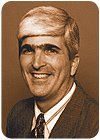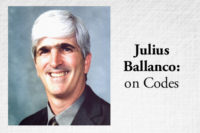
Last month I attended an International Association of Plumbing and Mechanical Officials (IAPMO) Committee meeting in Ontario, CA. During a crucial discussion on the engineering design of DWV systems, one of the participants stated that the plumbing code is for the plumber.
In the room, at the time, were plumbers, contractors, inspectors, IAPMO staff and myself as the lone engineer. The comment raised a number of eyebrows, including mine.
We started a conversation of “Who is the plumbing code for?” Better yet, one could ask, who is the mechanical code for, or the fuel gas code, or the building code? You get my drift.

Original Intent
The plumbers in the group raised some interesting points. They traced the history of plumbing codes. There is no denying that plumbing codes were originally written for the plumber to understand. The plumber needed the regulations to make sure a plumbing system was installed in a sanitary manner. They also pointed out how every plumbing code has some language that reads identically to the original language in these early plumbing codes written for plumbers.The plumbers in the room contended that the plumbing code was, and always has been, for the plumber.
Of course, anyone in code enforcement considers the code to be for the inspector. It is the document that the inspector uses to do his job. Many of the sections are written so that the inspector can have the requirements upheld in a court of law, if it should come to that.
I took the position that the plumbing code was written for everyone-the plumber, the contractor, the architect, the engineer, the inspector and the public. This opinion wasn’t embraced by anyone in the group. The comment actually went over like a lead balloon.
This questioning all started during a discussion of adding to the code new sizing tables that are taken from the American Society of Plumbing Engineers’ (ASPE)Plumbing Engineering Design Handbook. I proposed that the tables should be added to Chapters 7 and 9 of the code. Others thought they belonged in the index; still others didn’t think they belonged in the code at all.
The ones who did not want the requirements to appear in the code presented their argument that engineers know where to find the information. There is a section in the plumbing code that allows an engineer to design any plumbing system as an engineered design.
My response was, “How does an inspector know where to look to make sure the engineer designed the system correctly?” If the requirements are not in the code, an inspector may not have the ASPE documents necessary to check the design.
Those supporting the addition of the requirements to the appendix viewed the appendix as a part of the code. The numbered sections are for the plumber; the appendix is for the engineer (and others).
Whether the appendix is a part of the code depends on where the code is adopted. I indicated that any smart engineer knows how to use the appendix to design an engineered system. Furthermore, they know how to get that system approved by the inspector, if the requirements are in the appendix.
There never was a decision about whom the code was intended for. But when it came time to vote, the vote was to add the new requirements to the appendix of the plumbing code under the engineered design. I voted in favor of the motion.
On my flight home, I started to wonder if this has also been a part of the problem in bringing IAPMO, International Code Council (ICC) and Plumbing-Heating-Cooling Contractors-National Association (PHCC-NA) together for a single model plumbing code and mechanical code. If everyone cannot agree on whom the code is for, that could result in stumbling blocks along the way.
Tribute to President Gerald Ford
This meeting took place the day after President Gerald Ford passed away. I always admired President Ford. One of the reasons that I always liked President Ford was because, like myself, he was an Eagle Scout. I am very proud of being an Eagle Scout, and Gerald Ford was always very proud as well.What a lot of people don’t know is that Gerald Ford was also a Distinguished Eagle Scout. A Distinguished Eagle Scout is awarded to adults who have shown continued outstanding dedication to public service. The adult must be an Eagle Scout for at least 25 years. Other Distinguished Eagle Scouts include Donald Rumsfeld, Ross Perot and Steven Spielberg.
While mourning the loss of Gerald Ford, I wondered what he would have said regarding the code-or for that matter, what he would have said regarding the joining of the codes. I have an idea that President Ford wouldn’t have pulled any punches and would have said that the plumbing code is “for every American.”
I also know that President Ford would have locked everyone in the room and said, “Let’s join these two codes. Let’s get down to business.”
He was a leader that cared more about the United States than he did about party politics. As a Republican, he liked Democrats, and Democrats liked him. He could always work with both sides, argue his point and strive to do what is best for the country.
I know that when I voted on the recommendation, I was thinking about President Ford-Eagle Scout President Gerald Ford. That is why it didn’t matter to me if the new DWV requirements appeared in Chapter 7 and 9, as I thought was appropriate, or the appendix. What mattered is that the code was correct for every American to use.
The current requirements could result in failures in large engineered systems. By having the new sizing requirements in the appendix, hopefully, every engineer will follow this design criteria, especially for multistory design.
As to whom the plumbing code, mechanical code, fuel gas code, and building code are for, they are for the public. They provide an ordered society and protection of public health, safety and welfare. We are all a part of the public, whether plumber, contractor, inspector, architect or engineer.


